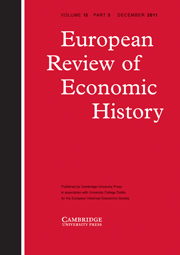Article contents
Reparation transfers, the Borchardt hypothesis and the Great Depression in Germany, 1929–32: A guided tour for hard-headed Keynesians
Published online by Cambridge University Press: 07 September 2006
Abstract
This paper examines the effects of Germany's inter-war reparation agreements in the framework of the Keynesian transfer problem. According to conventional wisdom, with free capital mobility reparation transfers are necessarily under-effected. I argue that while this is true for the Dawes Plan period between 1924 and 1929, the Young Plan for German reparations after 1929 created an external credit constraint such that during the depression, no counteracting capital flows could come forth and reparations were fully (or over-) effected. This is consistent with the so-called Borchardt hypothesis, which claims that stabilisation policy in Germany during the Great Depression was credit constrained and that lack of budgetary discipline during the preceding years was instrumental in creating this constraint. Accounting for the foreign credit restriction created by the Young Plan, Germany's deflationary policies during the slump can be interpreted as the austerity reaction to an imminent foreign debt crisis. The balance of payment stabilisation required by the Young Plan explains most of the decline in German national product during the depression if Keynesian import functions are assumed and suitably parameterised. Simulation of various different transfer profiles suggests that with tighter macroeconomic policies during the Dawes Plan period after 1924, a large part of the income contraction after 1929 could have been avoided. The results imply that both parts of Borchardt's hypothesis hold up even under plainly Keynesian assumptions.
- Type
- Articles
- Information
- Copyright
- Cambridge University Press 1998
- 26
- Cited by


